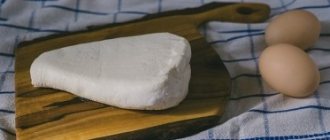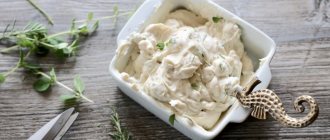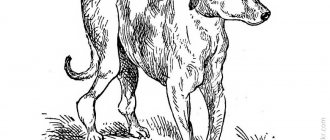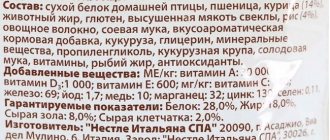A lot depends on how a dog eats while growing. If you take care of your puppy during this period, the result will be a healthy and sincerely loving friend with whom there will be a minimum of problems.
It is very important that the animal’s bones and musculoskeletal system are properly formed so that they are strong. A food product such as calcined cottage cheese will help in this matter.
Cottage cheese with high calcium content
Soviet textbooks on pediatrics also suggested introducing calcined cottage cheese into a child’s diet in the first year of life as complementary foods. It was considered the most important source of calcium during the period of active growth of skeletal bones and teething for babies. Many cookbooks of that period contained advice on how to make calcined cottage cheese at home. For the same reason, gynecologists recommended that pregnant women eat cottage cheese enriched with calcium , since if there is a lack of calcium in the pregnant woman’s food, it is extracted from the mother’s bones and teeth for the needs of the fetus.
Books on cynology, in the section on the nutrition of adult dogs and young animals, also recommended cottage cheese with calcium chloride as an obligatory component of the diet - the recipe was given there. This kind of cottage cheese was prepared by dog breeders for puppies at home during the period of changing milk teeth and for dogs during the period of bearing and feeding their offspring . It had to be done immediately before feeding the animals, taking into account the time for the whey to drain.
At home, to obtain this product, pharmaceutical preparations - calcium chloride or calcium lactate - are dissolved in the original ingredient. Cottage cheese is made at home from milk (usually cow's, less often goat's) and kefir.
Diet for dogs with kidney disease.
During the Soviet period of the 20th century, the tendency in veterinary medicine to prescribe a low-protein diet to such dogs was firmly rooted. When the dog gets almost no meat in his diet. And his diet consists mainly of cereal porridges with vegetables. But, firstly, such restrictions should not be prescribed for any kidney disease. But only for severe and advanced forms, complicated by chronic renal failure. And secondly, a dog is still a predator, no matter how you look at it. Well, you can’t force her to be a vegetarian. Such a restriction will ultimately do more harm than good.
However, such a diet can be prescribed. In this case, the amount of meat in the diet should be reduced gradually. Maybe take the path of reducing the single portion. Or try to find a more or less complete replacement for the prohibited product. Again, it should be emphasized that such issues can only be resolved with the participation of a specialist.
Currently, such dogs are transferred to specially created food. Dietary food for dogs with kidney disease allows you to competently solve the problem of complete and proper nutrition.
Benefits and harms
In addition to how to prepare cottage cheese with calcium chloride (the recipe, in general, couldn’t be simpler), many Internet users are interested in whether calcium chloride in cottage cheese is harmful for children or adults, and in general, why calcium chloride is added to cottage cheese if this product already the richest in calcium among all fermented milk products.
for a child if the permissible amount of calcium in the cottage cheese is maintained, and the product itself is fresh and stored in compliance with all rules . Excess calcium leads to disruption of metabolic processes in bone tissue, which weakens it. In addition, this element, when the limit of its normal content is exceeded, interferes with the absorption of other elements - zinc, copper, phosphorus, magnesium - which inhibits the functioning of internal organs and can cause poor health. Therefore, it is important to follow the recommended amount of calcium chloride in cottage cheese.
The benefits of calcium are that it strengthens bone and dental tissue, activates the immune system and helps it resist infectious diseases, suppresses the production of histamine and alleviates allergic reactions. Therefore, a product enriched with calcium using pharmaceutical preparations is indicated not only for children and pregnant women, but also for the elderly, allergy sufferers and people with weakened immune systems during seasonal respiratory diseases.
Dietary food for dogs with kidney failure.
Many kidney diseases in dogs are asymptomatic or their manifestations are mild. And the dog will not say anything about his unfavorable moments. And the owners of such dogs are not always attentive to manifestations of kidney disease. Often the symptoms are not assessed seriously and are not a cause for alarm. This leads to the fact that the disease is often detected only at a late stage. The result is a statement of the fact that a formidable complication has already developed - chronic renal failure. The diagnosis is made based on laboratory tests.
The treatment will necessarily include an appropriate diet for dogs. Therapeutic foods for dogs with chronic renal failure are labeled Kidney or Renal. These include Hill's Prescription Diet k/d, Happy Dog Renal, Royal Canin Renal RF14. Keeps protein, sodium and phosphate levels low. Their use will greatly simplify the removal of toxins from the blood and improve the well-being of a sick pet.
How to make deliciously healthy cottage cheese
To prepare not only healthy, but also tasty calcined cottage cheese, you need to meet a number of conditions. Making cottage cheese using calcium chloride is generally simple:
- take only fresh milk or kefir, in no case with an expired expiration date;
- heat the original product over very low heat and bring to a temperature no higher than 40 degrees;
- add calcium chloride to warm milk, mix thoroughly and continue heating to high temperatures (80-90 degrees), without letting it boil;
- wait until the whey separates and the curd flakes rise to the surface;
- Cool slightly at room temperature and drain in a colander. If there are large holes in it, then line it with 3-4 layers of gauze. There is no need to line the mesh.
Curd made from milk and calcium chloride
This option is ideal for children and those recovering from a long illness or following a specific diet. In addition, it is much healthier than store-bought and you will always be confident in the quality of the product.
Ingredients:
- milk (fat content 3.2%) - 200 ml
- calcium chloride (10% solution) - 3 tsp.
Cooking steps:
Heat the milk in a water bath to 70-80 degrees (but do not bring it to a boil!). Add 3 tsp. calcium chloride solution. This solution is sold in pharmacies and is intended for injection.
Stirring constantly, bring the mixture to a boil.
After about 10-15 minutes, the mixture will begin to curdle and separate into curds and whey. Boil for a few more minutes. This cottage cheese turns out completely without sourness and is very tender, the grains are very small, which makes it an ideal product for kids .
Place the cottage cheese in a sieve or colander with sterile gauze. Squeeze lightly and allow excess liquid to drain. Dietary healthy cottage cheese is ready.
Cooking features
Why does cottage cheese turn out pasty or grainy? There are several reasons. Excessive graininess may be due to the rate of heating of the mixture. The faster the heating occurs, the more grainy the final product is. The moment of cooling is also important. If you prefer paste-like calcined cottage cheese, then try to cool it to room temperature for as long as possible. For example, you can wrap a pan or place it near a radiator. The freshness and fat content of the milk can also influence how the healthy treat turns out.
Secrets and advice from experienced housewives
I am Mikhail, the owner of this site. I love to cook, and I have the appropriate education as a food industry technologist (more detailed information here). True, I work in a different field, but I enjoy doing what I love in my free time. Everyone at home likes it, especially my wife))) I’ve also been a vegetarian for several years, which is why there are so many eggless cottage cheese recipes on the site.
A lot depends on how a dog eats while growing. If you take care of your puppy during this period, the result will be a healthy and sincerely loving friend with whom there will be a minimum of problems.
It is very important that the animal’s bones and musculoskeletal system are properly formed so that they are strong. A food product such as calcined cottage cheese will help in this matter.
A self-organized diet is self-medication.
There are “diets” that are formed spontaneously by the dog owner. Most often this happens with allergic reactions. So they gave the dog a product: one, two, three. The result is allergies to all three. What does the owner do? He begins to feed only what the dog can definitely tolerate. For years. Does it seem logical? But it turns out that the pet was put on a diet that may not be healthy at all. Monotonous unbalanced diet. What's the result? After a couple of years, the dog has new problems. With fur, with digestion, maybe with the condition of the joints or reproductive capabilities. With anything! Like a snowball, it can add to one another. Trips to the veterinarians begin. Considerable financial costs, because time is lost.
But all in all, at one time it was necessary to solve the problem with a veterinarian in a timely manner, and not to be clever yourself. Because no one will ever solve such a problem without special education. The diet for dogs is selected only by experienced specialists. For example, you can take a foodborne test. But this is about 3 dozen positions! And then select dietary food for the dog according to its needs.
Therefore, you need to remember that diet is also treatment. And any self-medication can easily harm a dumb pet. Who does not have a free choice of what to eat or what product to choose.
What it is?
Many people have heard the concept of “calcined cottage cheese,” but what it represents in practice is not entirely clear. In fact, this is a regular fermented milk product, to which, for greater benefit, a preparation containing calcium is added : calcium chloride solution or calcium lactate powder.
Benefits for people
Calcined cottage cheese is considered a record holder for calcium content; its amount in it is several times greater than in a regular product. Calcified cottage cheese tastes blander (which is why not all kids eat it with pleasure), and it has a more uniform consistency. It is also low acidic, making it easily digestible.
The macronutrient calcium is important for the body of both humans and dogs. Calcium is actively used in the growth of teeth and bone tissue, and has a good effect on muscle-nervous conduction and the process of blood clotting.
In addition, calcined cottage cheese is considered not only rich in calcium, but also simply a dietary product. The product is especially useful for the following groups of people:
- children under one year old (often prescribed complementary feeding not with ordinary, but with calcined cottage cheese);
- teenagers;
- pregnant and nursing mothers;
- elderly people (their bones become more fragile with age and need strengthening);
- patients with calcium deficiency, kidney and liver diseases, hypertension, anemia and atherosclerosis.
For dogs
For dogs, calcined cottage cheese is also absolutely necessary , namely:
- for the formation of strong teeth and bones;
- maintaining muscle tone;
- proper operation of the mechanism of transmission of nerve impulses;
- normal hematopoietic process: improved blood clotting, platelet reproduction;
- maintaining cellular metabolism;
- improving the functioning of digestive enzymes.
Calcium reserves in a dog's body need to be replenished regularly. Puppies and adolescents who are in the active growth phase, older dogs with age-related changes in bone tissue, and pregnant and lactating bitches especially need calcined cottage
The development of the puppy until the end of the lactation process is directly related to the healthy diet of the mother. So during this period, the bitch is in dire need of healthy food - including calcined cottage cheese.
Much is said about the benefits of calcined cottage cheese, but in excessive doses it can harm the animal . It is not worth giving it on an ongoing basis.
Please note that if there is an excess of calcium in the body, a disease will begin - hypercalcemia, which is even more dangerous for puppies than a lack of calcium. Here's how the effects of excess calcium :
- curvature of the radius bones;
- osteochondrosis;
- secondary mineral deficiency: excess calcium prevents the full absorption of copper, zinc, phosphorus, magnesium;
- hypertrophic osteodystrophy.
It is worth refusing such a treat if the dog breed is very small (pug, chihuahua, Yorkshire terrier, spitz, etc.) - they do not need a lot of calcium, but large breeds will require an additional resource for bone structure.
Also, do not forcefully give cottage cheese if you have tried several recipes, but the puppy stubbornly refuses to eat it. Many foods contain calcium, you can give vitamins - you shouldn’t force the animal, creating a persistent aversion to the bowl.
If the puppy is already on dry food , you cannot mix dry food with any, even the most healthy products, such as calcined cottage cheese. At least not without a recommendation from a veterinarian.
Note
There is probably not a person who does not know about the benefits of calcium. Our body needs it to maintain healthy teeth and strong bones. But is everything so simple and is this the only end of calcium’s mission? Can calcium be harmful, and if so, in what cases? A product enriched with calcium has a positive effect on the functioning of the nervous system, participates in the process of blood clotting, and activates enzyme processes in the body. Calcium forms bone tissue, strengthens teeth and nails. It also helps prevent age-related changes in bone tissue. Calcined cottage cheese is indispensable during the period of growth of children and adolescents; it is also indicated for pregnant women who share calcium reserves with their unborn baby. It increases hemoglobin levels in anemia and activates metabolic processes. Calcined cottage cheese is a natural replacement for expensive pharmaceutical drugs and is easily absorbed by the body. The benefits of calcium for our body are unconditional. But few people know that it brings this benefit in tandem with other elements. Thus, without phosphorus, maintaining healthy bones and teeth would be impossible, and without magnesium, calcium would not be able to ensure the functioning of the cardiovascular system. But you don't have to run to the pharmacy for vitamin D, although it won't hurt either. Daily 15-20 minute exposure to the sun guarantees our body the full independent production of the vitamin D we need. However, the beneficial properties of calcium are not limited to its effect on teeth and bones. Why do we need calcium?1. It is directly involved in the processes of muscle contractility and the excitability of nerve tissue. If you experience cramps and muscle spasms, if you feel tingling in your wrists and feet, you do not have enough calcium;2. – is one of the elements that participate in the formation of blood clots that clog tissue ruptures; 3. It is one of the elements that make up the cell nucleus and membrane, and also affects the permeability of membranes; 4. Part of tissue and cellular fluids; 5. by blocking the absorption of saturated fats in the gastrointestinal tract;6. Calcium plays a key role in the activity of the pituitary gland, adrenal glands, gonads, pancreas and thyroid gland. As you can see, calcium is useful for the body as a whole, and not just for its individual organs. However, large amounts of calcium are washed out of the body every day, and the consumption of caffeine, proteins and salt contribute to this process. Eliminate these foods from your daily diet, or at least reduce their consumption, and you will bring invaluable benefits to your health! When consuming foods containing calcium, it is important not to overdo it and not harm yourself and your health. Excessive absorption of calcium leads to hypercalcemia - increased levels of this substance in the body. In this case, calcium harm will be indicated by the following symptoms: General and muscle fatigue, drowsiness, poor concentration, depression; Weight loss, vomiting, nausea, lack of appetite; Dehydration, nephrocalcinosis, polyuria; Arrhythmia, hypertension, valvular calcification and blood vessels; Bone pain, myalgia. Excessive calcium intake is dangerous for pregnant women - it can disrupt the formation of the skeleton and lead to ossification of the skull and fontanel, which causes complications during childbirth and can cause birth trauma. Calcium chloride is used not only for medical purposes , but also as a food additive. A special additive, classified as an emulsifier, is used in the production of fermented milk products, promoting their thickening and increasing the final yield of the finished product. In addition, calcium chloride is often included in jams, preserves, and other preserved fruits and vegetables. It is available in powder form and in moderate doses does not pose a health hazard. Despite the exceptional usefulness of the product, homemade calcined cottage cheese should be consumed with caution, not exceeding the limits permitted by doctors. Exceeding the norm can lead to disruption of metabolic processes in the body. Excess calcium threatens health problems such as nausea, thirst, vomiting, and night cramps. Confusion and impaired brain function may also indicate excess calcium intake. In addition, cottage cheese contains a large amount of protein, an excess of which can lead to the deposition of kidney stones and other health problems. Do you have difficulty digesting whole milk? Calcined cottage cheese will be an excellent alternative to a popular source of calcium, since an order of magnitude less digestive enzymes are released for its absorption. It is also indicated for people who are obese or watching their weight. A serving of calcined cottage cheese for breakfast means healthy well-being for the whole day, energy and a boost of vigor without compromising your figure. Doctors often prescribe the consumption of calcined cottage cheese after fractures. Tasty medicine promotes a speedy recovery. And by preparing it at home, you can be completely confident in its quality and freshness. Before giving calcined cottage cheese to children, you should consult your pediatrician. This will avoid health problems associated with a possible excess of calcium.
Does it make sense for an adult pet?
There is some debate about the benefits of this product for an adult dog. On the one hand, as you grow older, dairy products begin to be absorbed worse; they are no longer required in large quantities. On the other hand, calcium is an element that is constantly required in the body.
An adult dog’s digestion can adjust to calcium levels. With its excess, digestibility decreases, and with a deficiency, it increases. But this does not mean that the animal will be able to endure a long-term shortage or excess of this macronutrient without consequences for the body.
It is best to feed calcined cottage cheese until 3 years of age , and then stop eating it. An exception, as mentioned above, is made for pregnant, lactating and elderly individuals.
If your animal has a calcium deficiency, do not rely on the super benefits of this product; in adulthood, calcined cottage cheese is less digestible .
Give preference to special vitamins or nuts, peas, beans, oatmeal - they are also rich in calcium.
Hypoallergenic dietary food for dogs.
The choice of food depends on the list of foods intolerant to the dog, its preferences and many other factors determined by the veterinarian. On the part of the owner, the choice depends on financial capabilities and trust in the brand. Feeds of a lower class than “super-premium” may contain chicken, which itself is often an allergen. This should be remembered. As well as the recommended consumption rates on the packaging.
Such medicated dog food does not contain artificial industrial additives or any allergenic compounds. They are usually classified as Hypoallergenic and labeled as such. Examples of such foods are Royal Canin Hypoallergenic DR21, Pro Plan Veterinary Diets HA Hypoallergenic, Hill's Prescription Diet z/d Food Sensitivities. Grain-free foods labeled Grain-Free are also hypoallergenic. They do not contain gluten, so they are indicated for gluten intolerance. In particular, in the treatment of celiac disease.
Hypoallergenic dietary food for a dog should be prescribed to it for life.
How to make it at home?
Self-production of calcined cottage cheese is based on adding a 10% calcium chloride solution (it can be bought without a prescription and inexpensively at a pharmacy).
If you can't cook
Today, calcined cottage cheese can be bought in the store without any problems. But it’s better to cook it yourself , because you don’t know what exactly the manufacturer put in the cottage cheese. Sometimes artificially increasing calcium in cottage cheese is not done in good faith, which leads to problems.
Therapeutic food for dogs with urolithiasis.
The disease develops as a result of pronounced changes in metabolism. Stones that form in the kidneys and urinary tract cause significant suffering to the dog. A diet for dogs with this disease can make their life much easier. Urinary class foods are used: Advance Urinary, Hill's Urinary Care and Pro Plan UR Urinary dry. These feeds are mineral balanced according to a special formula. Their use helps prevent stone formation in the urinary tract. They also have an anti-inflammatory effect on the bladder and kidneys.
When and how to give?
You can give cottage cheese to puppies from the first month of life, but not more than 2-3 times a week. Serving size depends on age:
- 20 g per day is enough for up to a month;
- 2-3 months – 50 g per day;
- from 3 months to 3 years – about 100 g per day.
Cottage cheese can be mixed with various things that are tasty for the puppy so that he eats it better. It is worth diluting the calcined cottage cheese with whey to a liquid slurry, add 1 tbsp. Sahara. Even a baby will happily eat this sweet mixture.
The remaining whey can be given to the puppy's mother - this product also contains a lot of calcium.
Diabetes mellitus in a dog.
The veterinary line for diabetes contains Diabetic class food. They are the basis of the lifelong diet of such dogs. With the help of this line of food it is easier to control blood sugar levels. Dogs with diabetes should not be given easily digestible carbohydrates. Their protein content is also reduced and they contain a small amount of carbohydrates in the form of fiber. The food is rich in vitamins and mineral components. These include Farmina Vet Life Diabetic, Advance Diabetes Colitis and Royal Canin Special Low Carbohydrate.
These medicated dog foods are quite nutritious and easily digestible.
What else does a growing body need?
To avoid calcium deficiency, your puppy can be fed:
- crushed eggshells;
- bone meal;
- fish (it needs to be boiled and ground together with bones - a valuable source of calcium);
- beef liver;
- special bones with calcium.
There is no need to give it all at once; for a puppy, the main source of calcium is milk . Only if it is not enough, choose another additional product or alternate them.
Also, in order for the dog to develop healthy , it needs to be given:
- Dairy products – up to 3 months this is the main diet;
- Meat (main focus on beef and veal);
- Boiled liver;
- Fish (at least once a week);
- Vegetables: carrots, white cabbage, bell peppers, beets, zucchini, cucumbers, pumpkin;
- And, of course, clean water.
Diet for dogs with diseases of the digestive system.
Gastrointestinal diseases in dogs are very common. Therefore, dietary nutrition plays an important role in their treatment. Since gastrointestinal diseases are quite diverse, the veterinarian will develop a diet for your pet individually. For example, hepatitis often requires a reduction in the protein component in the diet, as well as the amount of fat. There are specific dietary features for pancreatitis and intestinal diseases. In this case, the specialist will focus not only on the diagnosis. But also on the characteristics of the breed, the dog’s previous nutrition, the stage and degree of manifestations of the disease. And also take into account the breed, constitutional and individual characteristics of your pet. His size, age, lifestyle.
Frequent reasons for prescribing such a diet are acute gastritis or gastroenteritis. It is characterized by:
- Using a line of grain-free dietary foods that are gentle and do not irritate the mucous membrane of the digestive tract.
- When feeding naturally, avoid fatty meat and any fish. In the first week of treatment, any meat products are completely excluded from the diet. Meat is introduced gradually from 2 or 3 weeks in the form of a mixture of semi-liquid porridge and minced meat, gradually increasing its quantity.
- The acute period at the onset of the disease requires a fasting diet for 1-2 days. After which you can start feeding the dog vegetable broths with chopped boiled eggs. Or low-fat kefir.
- From the second week you can give chopped steamed vegetables. By excluding those that cannot be fed to the dog. And also oatmeal or rice porridge, cottage cheese.
- Then the diet can be expanded, but only a veterinarian will determine this. Bones, sausage, raw milk, and any human food are strictly excluded.
These principles apply to weak digestion and a tendency to diarrhea. It is also important to maintain proper drinking regime.
What is calcined cottage cheese
The concept of “calcined cottage cheese” is familiar to many, however, what exactly the product is is not known to everyone. In fact, calcined curd is a fermented milk product to which one of the pharmaceutical preparations is added - a solution of calcium chloride (in droppers, ampoules, bottles) or calcium lactate powder.
Such calcium supplements are sold in all pharmacies and are easily available without a prescription. However, you should not add them to cottage cheese in unlimited quantities . Firstly, an excess of such a macronutrient is harmful to health, and, secondly, it will negatively affect the taste - homemade cottage cheese will begin to taste bitter.
Problems in organizing dietary nutrition.
The diet for dogs prescribed by a veterinarian must be strictly and accurately followed. But this is precisely what causes a number of problems for owners:
- Lack of readiness to change diet. Example: the required product is not yet available - I’ll feed you the same, no problem. Hence the unreasonable substitution of products. Or for example: the dog doesn’t like this, why not replace the rice with millet, since these are all cereals?
- Humanization and excessive pity for the pet. “Oh, you dog, you sufferer, you love chicken so much. Well, at least I’ll pamper you on weekends - there won’t be a big disaster!”
- Dietary irregularities and missed feedings. Here it’s the other way around - since you’re on a diet, it’s not harmful to go hungry, otherwise I’m here for work for a day - who will monitor the nutrition? Or: here are friends visiting, and even with children, is it really possible to forbid them? Well, they’ll treat you to sweets, but that’s not every day.
If you value your pet's health, you should be persistent. And follow the veterinarian’s recommendations strictly and without the slightest deviation.
A diet for dogs used for a wide variety of diseases is an important component of their treatment. Dietary dog food will help maintain its health in a variety of situations. The main thing is to use dietary nutrition correctly and as prescribed by a specialist.
Yagovitin M.Yu.
What are the benefits of calcined cottage cheese?
A macronutrient such as calcium is extremely necessary for our body. It is involved in the formation and strengthening of teeth, bone tissue, and the substance also has a beneficial effect on neuromuscular conduction and the blood clotting process.
Moreover, calcined cottage cheese is a dietary product that is easily absorbed by the human body at any age.
Cottage cheese prepared with calcium chloride is especially useful for the following groups of people:
- babies under one year old (complementary feeding with cottage cheese made from calcium chloride is carried out only after consultation with a pediatrician);
- children aged 1 year and older;
- teenagers;
- pregnant, lactating;
- To old people;
- everyone who suffers from calcium deficiency, kidney disease, liver disease, atherosclerosis, anemia, and hypertension.
In addition to children, pregnant women, and the elderly, calcined cottage cheese is also given to dogs. The indications for using this product in dogs are the same as in humans. You can make cottage cheese from calcium chloride for a puppy or an adult dog using the same procedure as for a baby. Recipes for making homemade calcined cottage cheese are given below.
The most common hypoallergenic medicated dog foods.
Bosch Sensitive.
Medicinal food from the German manufacturer Bosch Sensitive belongs to the super-premium class food. They are balanced in all nutrients. Contains PUFAs and prebiotics. It is based on rice and lamb meat. It also contains barley, potato flour, beets, dried egg, mussel and flaxseed flour. And also the meat of the New Zealand green-lipped mollusk, which is a source of glycosaminoglycans.
1ST CHOICE HYPOALLERGENIC choice.
Specially created dietary food for dogs with food allergies. Contains duck meat, beet and potato flour. Sources of vitamins include dried blueberries, green tea and chicory extracts. Also present are mint, parsley, ginger, and taurine. The food reduces gas formation, eliminates nausea and unpleasant odor from the mouth, and improves digestion.
Pro Plan.
It is represented by two lines of hypoallergenic food - each is divided into food for dogs of different sizes. The first food is for dogs with sensitive digestion, and the second is for dogs with problem skin. The Optidigest mark is for the first food, it is based on lamb meat. It also contains dried poultry protein, corn, wheat, chicory, minerals, and vitamins. The second food is made from salmon.
Lamb&Okanagan Apple by Akana.
Grain-free food based on New Zealand lamb, also includes carrots, pumpkin and apples. It is considered very balanced due to the variety of selected additives. These are green peas, chicory root, ginger, seaweed, lemon balm, mint, green beans. Among the additional animal components there are lamb kidneys and fat, liver. Designed for pets with sensitive digestion.
Royal Canin ANALLERGENIC.
Balanced and does not require additional minerals and vitamins. Made with hypoallergenic cornstarch and a variety of meat options. Contains antioxidants that bind free radicals. Used in dogs with disorders of the digestive system and skin. Participated in studies that showed the clear effectiveness of this food. And a beneficial effect on the skin with food allergies.
Skin&Food Sensitivities.
Wet medicated food for dogs with an eloquent name. They are also intended for the treatment of skin manifestations of allergies and digestive disorders of the same nature. Available in canned form. The feed contains salmon, potato starch, vegetable oil, fish oil, taurine, antioxidants, and microelements. 370 g (one can) is nutritionally equivalent to approximately 100 g of dry food.
Brit Care Adult Medium Breed Lamb & Rice.
Representative of a Czech brand widespread in Europe. There are varieties depending on the age and weight of the dog. Most suitable for dogs of medium size and age. The food is based on lamb and rice. Also includes fish and poultry fats, yeast, vegetable and fruit extract. Processed crustacean shells are a source of glucosamine.
Eukanuba ADULT ALL BREED.
Also intended for dogs experiencing skin or digestive problems due to food allergies. Used from one year of age. The special structure of food granules is designed for greater effectiveness in cleaning teeth. This achieves the removal of plaque and unpleasant odor from the mouth. The basis of the food is lamb meat and rice. Also contains wheat and barley, egg powder, corn, beets, fish oil, additional minerals.
Grandorf.
The company of the same name produces its products in Belgium and Italy. Foods are divided by breed and age and belong to the holistic class. A dog diet based on this food is considered one of the most balanced. All of them are also based on lamb and rice. Only one variety - based on white sea fish. All foods contain probiotics. Contains no soy, wheat, corn, beets or eggs, GMO or artificial additives, salt or sugar.
How to prepare calcined cottage cheese at home
If you are planning to make a product for a child , then use exclusively pasteurized milk. If you are preparing fermented milk medicine for an adult or elderly person , then take homemade milk (cow or goat). It will be too fatty for a baby.
Recipe No. 1. How to make calcined cottage cheese for a baby
Adhering to generally accepted proportions (1 tablespoon of liquid calcium chloride per 0.5 liter of pasteurized milk), we prepare calcined cottage cheese according to the following scheme:
- Heat the milk over low heat, bringing the mass to 40 °C.
- Add liquid (or powdered) calcium to the dairy product (stirring).
- Bring the milk to a boil (do not boil), without stopping stirring it. As soon as the milk begins to boil, immediately remove the pan from the heat and allow the contents time to cool.
- Place the cooled curd mass onto a sieve lined with double-layer gauze to drain the whey. To speed up this process, cover the cottage cheese with clean gauze and remove the curd mass under pressure.
As soon as the whey drains, the product can be considered ready.
Do not pour out the resulting whey; it contains even more calcium than the curd itself, so you can use it to prepare a lot in the future.
The whey can also be used as a moisturizer for dry cottage cheese. If your finished squeezed product becomes dry, pour a little calcined whey over it before serving.
It is not recommended to store prepared homemade cottage cheese with calcium for longer than 2 days.
Recipe No. 2. How to make cottage cheese from calcium lactate
If the pharmacy does not have calcium chloride in ampoules or bottles, then you can easily replace it with calcium lactate in tablets. This will not change the cooking technology, only the amount and type of calcium chloride in the finished product will change:
- Bring a liter of milk to a boil, remove the pan from the stove.
- Grind the tablets (8-10 pcs.) into powder and add them to the milk.
- We wait for the milk to curdle, then place the curdled mass on cheesecloth.
- When the whey has drained, the calcined cottage cheese can be consumed. To make the product have a more pleasant taste (this is especially important if you plan to give cottage cheese to a child), mix it with homemade yogurt, berries, vegetable or fruit puree.
Recipe
Knowing how to make homemade calcined cottage cheese, you can enrich your diet with a healthy and natural product. The recipe is extremely simple. You will need the following available ingredients:
- milk;
- calcium chloride solution (10%), which can be purchased at any pharmacy.
Milk should be heated to a temperature of 40 degrees and a solution of calcium chloride should be added to it. Proportions: for 0.5 liters of fresh milk – 1-1.5 tablespoons of solution (can be replaced with 3 grams of dry powder). The mixture is brought to a boil. The milk will turn into a curd. Immediately after this, the milk is cooled, the resulting curd is placed on a sieve lined with gauze, and the whey is drained. Soft and healthy calcined cottage cheese prepared at home! If you prefer a slightly dry product, then wrap it in gauze and put pressure on it for a while. From half a liter of milk you get about 100 grams of cottage cheese.
How to make cottage cheese for a puppy with calcium chloride
The technology for preparing calcined cottage cheese for a puppy is very similar to the traditional preparation of the product for children and adults. The only difference is that we will not cook using pure milk, but using a combination of milk and kefir.
Ingredients:
- Kefir – 1 l;
- Milk – 1 l;
- 10% calcium chloride solution – 2 ampoules of 10 ml (2 tbsp).
Preparation of calcined cottage cheese:
- Mix kefir and milk, put the resulting mixture on moderate heat, slowly warm the mass. Do not stir the product during heating.
- As soon as curdled flakes appear on the surface of the fermented milk mixture, add a solution of calcium chloride to the mixture.
- Bring the contents to a boil, but do not let it boil.
- After this, remove the pan from the heat and cool the curdled mass.
Using a slotted spoon, we take out the formed curd flakes, slightly pressing them to the edge of the pan, and transfer everything to cheesecloth. As soon as the remaining liquid has drained, cottage cheese with calcium can be given to the puppy.
Method three
In this case, it is necessary to bring half a liter of milk to a boil, then add a tablespoon of calcium chloride.
Now put the mixture in a water bath for half an hour. Clumps should form on the surface, which we carefully remove onto a sieve and grind. The resulting cottage cheese must be cooled, after which it is ready for use.
In all three cases, the calcium chloride solution plays the role of a thickener. But when using it in the preparation of fermented milk products, try to strictly follow the instructions and not exceed the dosage. Otherwise, the cottage cheese may not turn out or will come out with a bitter aftertaste.











